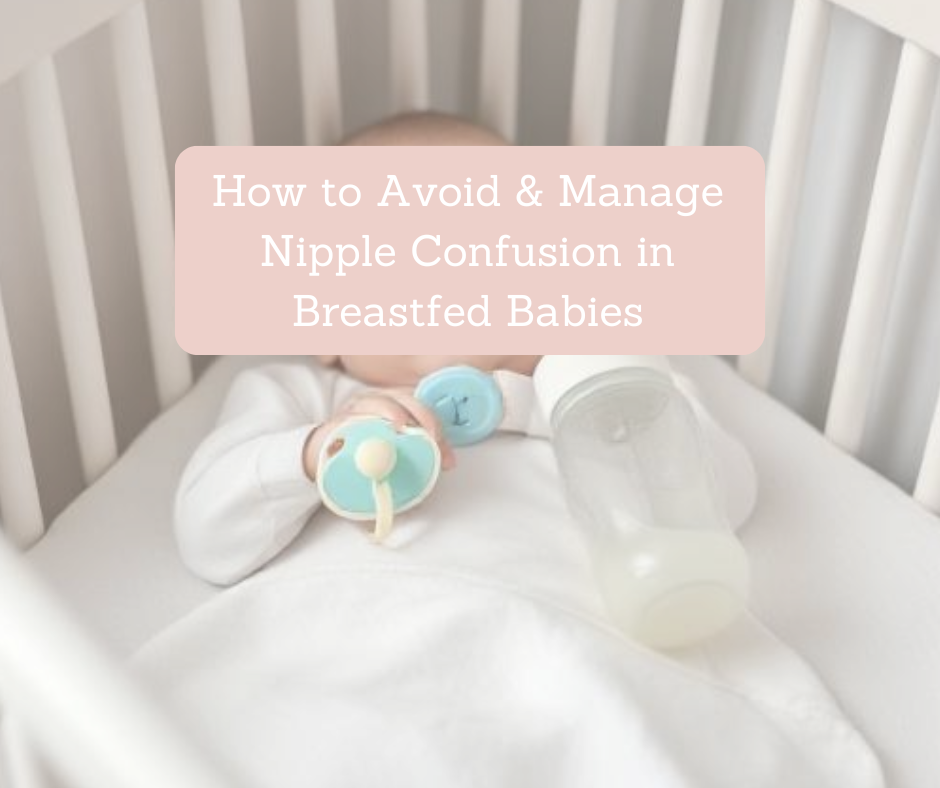
How to Avoid & Manage Nipple Confusion in Breastfed Babies
Share
If you’ve ever tried to introduce a bottle to your breastfed baby—or reintroduce the breast after a few bottle feeds—you might have felt the sting of nipple confusion.
I remember thinking, Wait, why is my baby suddenly rejecting me?
Or worse: Did I do something wrong?
Mama, if you’re in that in-between place where breastfeeding and bottle-feeding collide, know this: you’re not alone, and you didn’t mess anything up.
Nipple confusion is a real thing—but it's not the end of your breastfeeding journey.
Let’s break it down gently. No fear-mongering. Just clear, kind guidance to help you feed your baby your way—with less stress and more confidence.
What Is Nipple Confusion, Anyway?
Nipple confusion happens when a baby has trouble switching between breast and bottle (or pacifier), often leading to frustration, poor latching, or outright refusal of one or the other.
It’s not about the baby being difficult—it’s about how different those feeding methods feel in their tiny mouths.
The breast requires effort: suction, jaw movement, coordination.
The bottle often offers faster flow and less work.
So when a baby gets used to one, especially early on, the other can feel “off.”
Signs of Nipple Confusion
If your baby…
- Latches shallowly or inconsistently
- Gets frustrated at the breast or bottle
- Starts refusing the breast after a few bottle feeds
- Seems to choke or gulp milk from the bottle too quickly
- Pushes out the nipple or cries during feeds
…nipple confusion might be at play.
How to Avoid Nipple Confusion (If You Haven’t Introduced a Bottle Yet)
If you're still exclusively breastfeeding but plan to introduce a bottle or pacifier soon:
- Wait 3–4 weeks (if possible) until breastfeeding is well established.
- Use a slow-flow nipple to mimic the breast’s natural flow.
- Pace bottle-feeding: hold baby upright, offer pauses, let them “work” for it.
- Limit pacifier use early on—until the baby’s latch and milk intake feel consistent.
- Stay skin-to-skin often to keep the baby feeling connected to the breast.
How to Manage Nipple Confusion (If It’s Already Happening)
Take a breath, mama. You can work through this. Try:
- Going back to basics: lots of skin-to-skin, especially when the baby’s sleepy and less fussy.
- Switching to a slow-flow bottle if yours flows too fast.
- Breast compressions to help milk flow more easily during feeds.
- Offering the breast when the baby is calm (not starving or overtired).
- Using a nursing-friendly bottle technique, like paced bottle feeding.
- Working with a lactation consultant if you're feeling stuck—it’s not a failure to ask for help.
A Note on Bra Comfort During This Transition
When you’re navigating feeding challenges, physical comfort matters more than ever.
Choose a wire-free maternity bra with one-hand nursing clips—something like the one from Bloom & Heal—so you can respond quickly, adjust easily, and feel supported (literally and emotionally) while you troubleshoot.
Feeding might not go how you imagined. But you’re still doing it with love, presence, and care. That’s what matters most.
FAQs
Q: Is nipple confusion real, or is it a myth?
A: It’s real for many babies, though not all experience it. Some switch easily, others need more support and patience.
Q: When is the best time to introduce a bottle to a breastfed baby?
A: Around 3–4 weeks, once breastfeeding is well established. Every baby is different, so watch for consistent latching and milk transfer first.
Q: What bottle type is best for avoiding nipple confusion?
A: Choose a slow-flow nipple and a bottle designed for paced feeding. It’s less about brand, more about mimicking the breast’s feel and flow.
Q: My baby refuses the breast after using bottles—what now?
A: Try offering the breast during sleepy moments, using skin-to-skin, and compressing your breast to encourage flow. A lactation consultant can help tailor your approach.
Q: Should I stop bottles or pacifiers altogether if my baby is confused?
A: Not necessarily. Adjusting how you offer them (slow flow, paced feeds, timing) often resolves the issue without needing to stop entirely.

















































